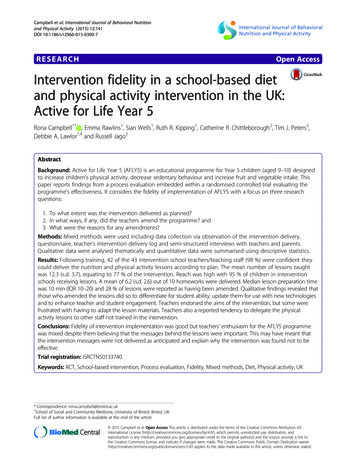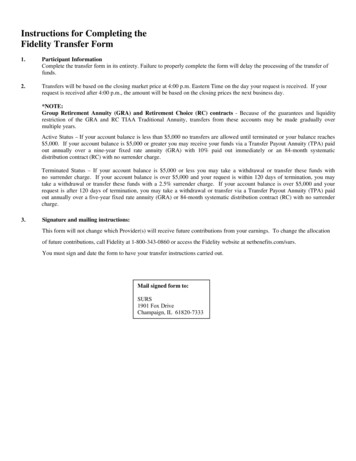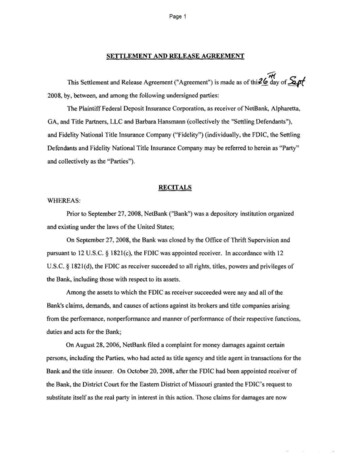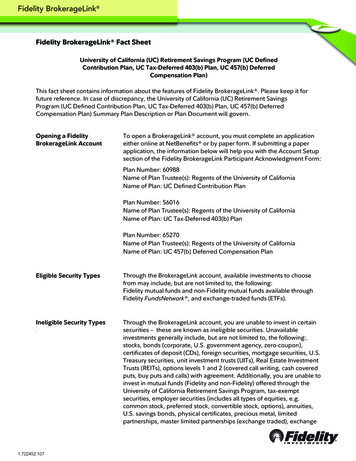
Transcription
Campbell et al. International Journal of Behavioral Nutritionand Physical Activity (2015) 12:141DOI 10.1186/s12966-015-0300-7RESEARCHOpen AccessIntervention fidelity in a school-based dietand physical activity intervention in the UK:Active for Life Year 5Rona Campbell1* , Emma Rawlins1, Sian Wells1, Ruth R. Kipping1, Catherine R. Chittleborough2, Tim J. Peters3,Debbie A. Lawlor1,4 and Russell Jago5AbstractBackground: Active for Life Year 5 (AFLY5) is an educational programme for Year 5 children (aged 9–10) designedto increase children’s physical activity, decrease sedentary behaviour and increase fruit and vegetable intake. Thispaper reports findings from a process evaluation embedded within a randomised controlled trial evaluating theprogramme’s effectiveness. It considers the fidelity of implementation of AFLY5 with a focus on three researchquestions:1. To what extent was the intervention delivered as planned?2. In what ways, if any, did the teachers amend the programme? and3. What were the reasons for any amendments?Methods: Mixed methods were used including data collection via observation of the intervention delivery,questionnaire, teacher’s intervention delivery log and semi-structured interviews with teachers and parents.Qualitative data were analysed thematically and quantitative data were summarised using descriptive statistics.Results: Following training, 42 of the 43 intervention school teachers/teaching staff (98 %) were confident theycould deliver the nutrition and physical activity lessons according to plan. The mean number of lessons taughtwas 12.3 (s.d. 3.7), equating to 77 % of the intervention. Reach was high with 95 % of children in interventionschools receiving lessons. A mean of 6.2 (s.d. 2.6) out of 10 homeworks were delivered. Median lesson preparation timewas 10 min (IQR 10–20) and 28 % of lessons were reported as having been amended. Qualitative findings revealed thatthose who amended the lessons did so to differentiate for student ability, update them for use with new technologiesand to enhance teacher and student engagement. Teachers endorsed the aims of the intervention, but some werefrustrated with having to adapt the lesson materials. Teachers also a reported tendency to delegate the physicalactivity lessons to other staff not trained in the intervention.Conclusions: Fidelity of intervention implementation was good but teachers’ enthusiasm for the AFLY5 programmewas mixed despite them believing that the messages behind the lessons were important. This may have meant thatthe intervention messages were not delivered as anticipated and explain why the intervention was found not to beeffective.Trial registration: ISRCTN50133740.Keywords: RCT, School-based intervention, Process evaluation, Fidelity, Mixed methods, Diet, Physical activity, UK* Correspondence: rona.campbell@bristol.ac.uk1School of Social and Community Medicine, University of Bristol, Bristol, UKFull list of author information is available at the end of the article 2015 Campbell et al. Open Access This article is distributed under the terms of the Creative Commons Attribution 4.0International License (http://creativecommons.org/licenses/by/4.0/), which permits unrestricted use, distribution, andreproduction in any medium, provided you give appropriate credit to the original author(s) and the source, provide a link tothe Creative Commons license, and indicate if changes were made. The Creative Commons Public Domain Dedication o/1.0/) applies to the data made available in this article, unless otherwise stated.
Campbell et al. International Journal of Behavioral Nutrition and Physical Activity (2015) 12:141BackgroundPhysical activity has been associated with lower levels ofcardio-metabolic risk factors, improved mental well-beingand a lower risk of obesity in young people [1]. Fruit andvegetable consumption is associated with lower caloric intake and a reduction in the risk of many forms of cancerand heart disease among adults [2–7], with patterns ofconsumption being established in childhood [4, 8]. Manyyoung people in the UK do not meet the current recommendation of an hour of physical activity on most days ofthe week [9, 10] and do not consume the recommended 5fruits and vegetables per day [11]. Developing strategiesto increase young people’s physical activity and fruit andvegetable consumption and decrease sedentary behaviouris an important public health priority.Schools provide opportunities to reach the majority ofchildren and as such have enormous potential to providephysical activity and nutrition focussed public health interventions [12]. Recent school-based interventions designed to improve diet and physical activity and decreasesedentary behaviour have reported only modest positiveoutcomes [3, 13–15] so more effective interventions arerequired. When designing new interventions it is important to learn from previous successes and failures[16–18] and assessing intervention fidelity is a key component of this process.Implementation fidelity is the extent to which an intervention is delivered as expected [18–23]. Assessing fidelity [19, 20, 22, 24–26] can help determine: whether andhow variations in delivery occurred [19, 23]; whether ornot the intervention was likely to be effective [19, 22];and how variations in delivery may have affected intervention outcomes [19, 23]. Once fidelity has been establishedthe sustainability of the intervention can be considered.An important aspect of sustainability is the potential levelPage 2 of 14of fidelity of implementation when the intervention is carried out in a ‘real world’ setting [22, 24]. Thus, in order toassess the sustainability of the intervention it is necessaryto consider how variations in delivery occurred and identifyaspects of the intervention that can be modified without compromising the underpinning theory and ‘spirit’of the intervention or having an adverse impact oneffectiveness.Active for Life Year 5 (AFLY5) was a cluster randomisedcontrolled trial in state primary schools designed to increase physical activity and fruit and vegetable intake whilealso decreasing sedentary time. The AFLY5 interventioncomprised of training for Year 5 teachers and LearningSupport Assistants on how to teach the intervention whichconsisted of 16 lesson plans, 10 homeworks in which thechildren were encouraged to work with their parent, twoparental information leaflets, and inserts for school newsletters. Table 1 lists the intervention elements, resourcesprovided and the delivery timetable. Control schools wereoffered the opportunity to receive the training and intervention materials after the final follow-up measurementswere taken in the summer of 2013.The effectiveness evaluation of AFLY5 found that therewas no difference in the primary outcomes of accelerometermeasured physical activity, sedentary time or self-reportedfruit and vegetable consumption among children in intervention compared to control schools, though there werebeneficial effects with respect to reducing self-reported consumption of high energy drinks, snacks and screen-viewingtime [27].This paper reports findings from a process evaluationembedded within the randomised controlled trial evaluating the programme’s effectiveness. It considers the fidelityof implementation of AFLY5 with a focus on three research questions:Table 1 AFLY5 Intervention elementsInterventionelementsResources providedDeliveryTimeframeTeacher trainingRefunded travel expenses1 day longSeptember 2011 toJanuary 2012LessonsHomeworkRefunded cost of supply teacher.Choice of 5 datesFolder containing:1) overview and lesson plans for 16 lessons:·10 physical activity focussed, 6 nutrition focussed·lasting 30–60 min2) Paper copies of worksheets for each child3) CD with further information and back-upcopies of materialsTeachers were strongly encouraged todeliver all 16 lessons. 8 lessons wereidentified as particularly important andteachers were told that if short of timethese 8 lessons should be prioritisedPaper copies of 10 homeworks for each childHomeworks were paired with specificlessons, but teachers determine timingof deliveryFrom training date untilMay 2012Back-up copies on CDFrom teacher trainingdate until July 2012Timing determined by teachersHand out informationleaflets for parentsPaper copies of 2 leaflets for each child:“Top Tips for Top Kids”“Freeze my TV tips for parents and guardians”Teachers determine timing of deliveryFrom training date untilMay 2012Snippets to be addedto school newsletters6 snippets provided on CDTeachers determine timing of deliveryFrom training date untilMay 2012
Campbell et al. International Journal of Behavioral Nutrition and Physical Activity (2015) 12:1411. To what extent was the intervention delivered asplanned?2. In what ways, if any, did the teachers amend theprogramme? and3. What were the reasons for any amendments?Findings from the process evaluation not included inthis paper are reported elsewhere, Lawlor D, Kipping R,Anderson E, Howe L, Chittleborough C, MoureFernandez A, Noble S, Rawlins E, Wells S, Mytton J, etal: Active For Life Year 5: A cluster randomised controlled trial of a primary school-based intervention to increase levels of physical activity, decrease sedentarybehaviour and improve diet. Forthcoming [28].MethodsThe AFLY5 trial was conducted in Bristol and North Somerset in England and ran from May 2011 to July 2013 [27].The intervention was delivered from September 2011 toJuly 2012 to children in Year 5 (aged 9–10). Sixty schoolstook part, with 30 schools randomly allocated to the intervention and 30 to the control arm. One school randomised to the intervention arm later decided not to deliverthe intervention but agreed to participate in trial data collection. All children in both the intervention and controlschools took part in a series of measurements at baseline(Year 4), post intervention (Year 5) and at follow-up oneyear later (Year 6) (see the trial protocol [29] and statistical analysis plan [30] for more details).Process evaluation data were collected at three different phases of the project. Phase one started before theintervention began; phase two ran during the intervention;and phase three began once the intervention had ended.Details of the number of participants in each of thesephases, and the methods used to collect and analyse thedata are provided below and summarised in Table 2. Datawere collected to evaluate the fidelity of intervention delivery, explore whether teacher, parent and child responseswere consistent with how the intervention was theorisedto act in our logic model and any potential barriers towider dissemination should it prove effective.Ethics and consentThe study was approved by the Faculty of Medicine andDentistry Committee for Ethics at the University of Bristol(reference number 111253). All adult participants providedwritten informed consent, while children gave writteninformed assent. (In England children under 16 cannotlegally give consent so when they agree to participate inresearch it is described as providing assent) [32].SamplingPhase 1: The five teacher training sessions, which involvedall participating intervention schools, were observed. AllPage 3 of 14participants were invited to provide structured feedbackby questionnaire.Phase 2: Observations of AFLY5 lessons being taughtwere carried out in all the intervention schools. Theintention was to visit at least one class in every school atleast once, and conduct two observations of each of thesixteen lessons being taught.Phase 3: All teachers trained in delivery of AFLY5 wereinvited to participate in a semi-structured interview. Sixintervention schools were purposively selected to ensureschools from localities with differing levels of areadeprivation and with differing levels of teaching standardswere represented. All study schools were defined as beingin an area of high, medium or low deprivation by splittingthem into thirds based on their score on the English Indexof Multiple Deprivation 2010 (IMD 2010) and into havinghigh or low levels of teaching quality defined by Office forStandards in Education (Ofsted) Scores [33]. (Ofsted is responsible for nationally assessing teaching quality inEnglish schools and we used the schools’ Ofsted scoresat the time of entry into the study in July 2011.) TheOfsted scores were Outstanding or Good (high teachingquality) and Satisfactory or Inadequate (low teaching quality). This process created 6 groups. Initially one school pergroup was randomly selected and approached for recruitment into Phase 3 of the study. If they declined or did notrespond another was randomly selected. When recruitmentslowed, all remaining schools were invited to participate ona first come first served basis. We aimed to interview twoto three parents per school, and if more parents than required offered to take part in an interview, parents were selected to ensure a mix of: parent and child gender andchildren from across the Year 5 classes (if appropriate).Data collectionDetails of all aspects of the data collected and the levelsof response can be found in Table 2. In phase 1 allteachers and Learning Support Assistants who attendedthe training were asked to complete the training evaluation questionnaires. In phase 2 lesson observations werearranged at a convenient time for the teachers. Data collected during observations of the teacher training and lessons were largely qualitative as they mainly comprised thedetailed notes written by the researcher describing whattook place, with the researcher paying particular attentionto specific topics such as level of engagement of those being trained or taught, questions asked and the suitabilityof the content for the ability of the group being taught. Allteachers involved with the delivery of AFLY5 were askedto complete intervention delivery logs and return these tothe research team. These logs sought information on, forexample, who taught the lessons, whether or not they hadbeen trained in the intervention, the date each lesson tookplace and how long it lasted. Teachers were also asked to
Method of datacollectionData collected from or byNumber completedResponse rateData collectiontimeframeData collectedData collectionformat100 % of sessionsobservedDuring trainingsessionsDetails on venue, number of trainerspresent, number ofparticipants, genderPro forma layoutPhase 1Teacher trainingobservationsObserving 43 teachers from 29 n 5intervention schools and 2trainers. (44 teachers wereinvited to the training butone was unable to attend.)Sessions ranDelivery and content of trainingSeptember 2011Teacher engagement and understandingJanuary 2012Questions or issues raised by teachersDetailed description of activitiesTeacher trainingTeachersevaluation questionnairen 43100 %Completed atthe end oftraining sessionFree form textFree form textFree form textFree form textReflection on the observation processFree form textWhether they felt confident that they hadenough knowledge to teach the nutritionand physical activity sessions successfully5 point scale:stronglyagree, agree, don’tknow, disagree,strongly disagreeWhether they felt confident to teach thelessons according to the plans5 point scale asaboveWhether they felt they needed moreinformation in order to teach the lessons5 point scale asaboveWhether they were confident at fitting all16 lessons into the allotted time frame5 point scale asaboveIndicating 3 key messages of AFLY5Free textIndicating how useful the day was interms of preparing for AFLY53 points: Veryuseful,useful in places, notusefulCampbell et al. International Journal of Behavioral Nutrition and Physical Activity (2015) 12:141Table 2 Details of data collected and analysed to assess and understand fidelity of intervention deliverySpace forcomments ifselected ‘not useful’Phase 2Lesson observationsObserving 30 lessons beingn 30taught in 24 of the 29 schoolsdelivering AFLY524 out of 30 (80 %)schools had atleast one lessonobservedDetails of lessons including: number ofchildren, gender, teacher identity codePro forma layoutObservation of the general behaviour ofchildren3 point scale: good,acceptable, poorObservation of the level of interest andenthusiasm displayed by the children3 point scale: high,indifferent, lowWhether delivery of key outcomes oflesson were metYes/noWhether resources provided were usedYes/noPage 4 of 1415/16 (94 %) lessonsobserved at leastonceNovember 2011to April 2012
11/16 (69 %)observed twiceTeacher interventiondelivery logs44 teachers in the 29 schoolsdelivering AFLY5n 44Whether homework was handed outYes/noMore detailed notes including:·layout of room·children’s behaviour and engagement·suitability of content for the ability ofthe group·aspects of the lesson that workedwell/less wellFree form text100 % for data ontotal number oflessons deliveredSeptember 2011- Teachers involved with delivery of AFLY5July 2012Their position in the school (e.g. NewlyQualified, Support Staff, Managerial Scale39 out of 44 teachersetc.)(89 %) providedWhether they attended the AFLY5 trainingpartial data on allother aspects of logInformation requested per lesson:·Who taught the lesson·Date taught·Number of children presentAmount of time spent preparing for thelessonPro forma tableYes/noPro forma tablePro forma tablerecorded in minutesAmount of time spent delivering thelessonWhether any other resources wererequired.Yes/no optionsIf so, what and how much did theycostPro forma tablerecorded in poundsWhether there were any difficulties withthe lessonYes/noIf so, whatWhether any amendments were requiredIf so, whatFree form textCampbell et al. International Journal of Behavioral Nutrition and Physical Activity (2015) 12:141Table 2 Details of data collected and analysed to assess and understand fidelity of intervention delivery (Continued)Yes/noFree form textWhat they would have been teachinginstead of AFLY5Free form textWho would have led this lessonFree form textWhether there was more or less preparation 3 point scale: more,for AFLY5 than usual lessonsless, sameYes/noHow many were completedFree form textThe quality of homeworks3 point scale: good,fair, poorPage 5 of 14Whether the homeworks were handedout
·teacher’s understanding of subject area·delivery style of teacher·input from other staff members·if the lesson was taught according tothe plan·reflections on the research processAny extra comments on both a per lessonbasis, as well as at the end of the logFree form textPhase 3InterviewsTeachers20 teachers from 15 of the 29schools delivering AFLY5n 2020 out of 44teachers (45 %)October 2012to April 2013Semi structured interview questions on the Audio recording/following topics:transcript·What contributes to a healthy lifestyleboth generally and for children·Teaching health promotion in schools·Whether they were involved with anyhealth promotion projects·Whether school-based health promotioneducation is effective in changing children’sbehaviour *Their experience of teachingAFLY5October 2012to April 2013Semi structured interview questions onthe following topics:·What contributes to a healthy lifestyleboth generally and for children·Whether they were aware of theirchildren taking part in healthy lifestyleslessons at school·Whether their child had bought homeany homeworks or information relating tohealthy lifestylesFace to face 14/20 (70 %)Mean length of interview 32 minRange 17–57 minPhone 6/20 (30 %)Mean length of interview 35 minRange 28–42 minParentsParents from the purposiven 14 (one interview had two 14 out of 18 (78 %)sample of 6 schools delivering parents present so counted asAFLY5two for number of participantsbut as one when calculatingmean/range of interview time)Face to face 7/14 (50 %)Mean length of interview 39 minRange 28–52 minAudio recording/transcriptCampbell et al. International Journal of Behavioral Nutrition and Physical Activity (2015) 12:141Table 2 Details of data collected and analysed to assess and understand fidelity of intervention delivery (Continued)Phone 7/14 (50 %)Mean length of interview 40 minRange 23–53 minCopies of all the instruments used in the process evaluation can be found in the AFLY5 process evaluation plan [31]Page 6 of 14
Campbell et al. International Journal of Behavioral Nutrition and Physical Activity (2015) 12:141record details of any amendments that they made. Inphase 3 semi-structured interviews were conducted withYear 5 teachers in intervention schools. Topics included,for example, what they thought contributed to a healthylifestyle, teaching health promotion in school and their experience of teaching AFLY5 lessons. Year 5 parents fromeach of the six intervention schools were invited to participate in an interview and asked what they thought contributed to a healthy lifestyle, whether they were aware oftheir children having been involved in any lessons atschool about healthy lifestyles and if their children hadbrought home any homeworks on healthy lifestyles. Withthe exception of two of the five teacher training sessionsthat were observed by a colleague, all observations and interviews were undertaken by ER who was not involved inthe AFLY5 intervention development, a point which wasmade clear to participating schools.AnalysisData preparationData were extracted from the teacher training evaluationquestionnaires and teacher intervention delivery logs andentered in an Access database. All handwritten teachertraining and lesson observation notes were typed onto astructured pro-forma and interviews were digitally recorded and transcribed in full. Data from observations,interviews, and free text from the teacher logs andevaluation questionnaires were entered into NVivo10(NVivo qualitative data analysis software; QSR InternationalPty Ltd. Version 10, 2012).Data analysisTo assess data consistency when calculating the numberof amendments made to lessons, a table was created tocompare data from the teacher logs and lesson observations on a lesson by lesson basis. Descriptive summarystatistics (means or medians, standard deviations or interquartile ranges and/or percentages) were calculated usingan on treatment approach for the following quantitativevariables: (i) training participants confidence teachingthe nutritional lessons (ii) training participants confidenceteaching the physical activity lessons (iii) lesson preparation time in minutes (iv) lesson preparation time thesame as or different from usual (v) number of lessons delivered (vi) the number of children receiving a lesson (vii)number of weeks over which lessons were delivered (viii)number of teachers providing AFLY5 lessons in eachschool (ix) training status of those delivering AFLY5 lessons (x) whether or not lesson were amended and (xi)number of homeworks given out.Qualitative data were analysed by ER in NVivo10 usinga thematic approach [34]. Codes were generated bothfrom the topics in the interview guides as well as iterativelyfrom the data, initially discussed with RK, and werePage 7 of 14categorised as a series of themes. The themes were discussed, refined and agreed by ER, RJ, SW and RC. Theyare illustrated in this paper by selected, anonymised quoteswhich typify the data from interviews or text extracts fromobservation notes or teacher’s logs.To maintain independence data analyses were undertaken by ER, SW, RJ and RC who were at that timeblinded to the outcome of the main trial [35]. The analysts of the trial effectiveness data did not discuss resultswith anyone and submitted the final draft effectivenesspaper to the chair of the AFLY5 steering committee.The analysts of this paper similarly submitted their finaldraft to the trial steering committee chair before seeingthe results from the effectiveness paper.ResultsQuantitative implementation fidelity findings on trainingand preparation, dose (number of lessons taught), reach(proportion of children receiving the lessons), and lessonamendments are presented below. The qualitative data,from interviews with 20 teachers (recruited from the poolof 29 intervention schools) and 14 parents (from thesample of six intervention schools), provide a more nuanced picture to contextualise the quantitative data.Quantitative and qualitative data on the modernisingamendments made to the lessons in terms of length,differentiation for ability and increased engagement arepresented before the final section which focuses on theteachers’ views of the intervention.It was not possible to recruit a sample of six intervention schools for each of the six possible combinations ofIMD and OFSTED score, however, there was an equalnumber of schools with high and low levels of teaching quality (three in each group) recruited, and twoschools per IMD group (low, medium and high) wererecruited.The extent to which the AFLY5 intervention was deliveredas plannedTraining and preparation44 teachers from 29 schools delivered the intervention.43 participants attended the training; 42 of these wereteachers and 1 was a learning support assistant. Data fromthe teacher training evaluation questionnaires indicatedthat 42 of the 43 (98 %) teachers/teaching assistantswho attended training agreed or strongly agreed with thestatements “I feel confident that I can teach the nutritionsessions as per the lesson plans” and “I feel confidentthat I can teach the physical activity sessions as per thelesson plans”. Teacher interview data indicated that, onthe whole, they appreciated having the opportunity towork through the programme during the training and,in particular, the opportunity to receive instruction onthe physical activity component:
Campbell et al. International Journal of Behavioral Nutrition and Physical Activity (2015) 12:141I think the training we got when we came for theActive for Life was really, really helpful ‘cause itcertainly pointed out a few things to us [ ] about likehow easy it was to run different activitiesPage 8 of 14.it went over a term or well over one term, normallyevery term’s like a fresh start, something completelydifferent [ ] so they need that chopping and changing‘cause otherwise [ ] they’d hate it and that’s withanything, that’s not just with Active for Life.School 15, teacher 2 interviewSchool 56, teacher 2 interview[ ] I really liked the physical exercise training. Andthe activities that were supplied. Thought that wasreally good and gave me lots of ideas. I still use them,even though I’ve moved on to a different class[ ] Ithought the lady who ran the course was quiteinspirational.School 50, teacher 3 interviewUsing data reported by the 39 teachers who noted atleast one lesson preparation time in the teacher log, themedian length of lesson preparation time calculatedacross lessons delivered was 10 min (IQR 10–20). Datafrom 38 teacher logs relating to 450 lessons showed thatfor 47 % of the lessons teachers indicated that morepreparation than usual was required, for 15 % less andfor 38 % the same amount of preparation time as usualwas required. During the interviews several teachers indicated negative feelings about the extra preparationtime required and noted that it was often required forthe physical activity sessions:I mean once the resources were made it was fine[ ] I don’t spend a lot of time preparing PE lessons.So I mean it might have been 15 min of readingthrough notes whilst it would have taken me 5 minnormally so we are not talking a lot of time but [ ]if it takes you 15 min and you are teaching it for45 min how much, how long does each lesson taketo prepare?41 of the 44 teacher logs were completed and returnedto the study team. The remaining 3 teachers were contacted by telephone and asked to provide only the number of lessons delivered and (if possible) the dates ofdelivery. Data from these 44 teachers showed that themean number of lessons delivered was 12.3 out of all 16lessons (s.d. 3.7, median 13.5 lessons, range 1–16 lessons)which equates to 77 % of the intervention. The meannumber of physical activity lessons delivered was verysimilar to that for nutrition lessons. Of the 41 teachersthat returned teacher logs, and indicated that they had delivered some of the intervention, all of them deliveredlesson 1, but delivery declined over the interventionperiod such that only 46 % delivered lesson 16. Seventeachers out of 41 (17 %) delivered all 16 of the lessons.The data from the teacher logs and interviews revealedthat by far the most commonly mentioned reason for notdelivering all the lessons was lack of time to fit all the lessons into an already full curriculum. This is explored further using data from the teacher interviews in the section‘what amendments were made to the intervention’.The mean number of homeworks delivered, calculatedfrom data given in the teacher logs, was 6.2 out of a totalof 10 (s.d. 2.6, range 2–10) equating to 62 %. Teacherswho did not hand out the homeworks stated in both theteacher logs and interviews that they had to prioritisecore skills homework above those from the intervention:All our homework is literacy numeracy at themoment, building up to end of year tests.School 10, teacher 2 interviewSchool 51, teacher 1, lesson 11- written extract fromteacher’s logReach and doseThe reach, or percentage of children receiving all of thelessons taught, calculated from teacher log data, was95 %. The timeframe over which the lessons were delivered was a median of 17.7 weeks (IQR 9.1–23.3). Theteacher logs indicated that there were two main patternsof delivery: a) a regular dose, fairly evenly spread out;and b) a varied dose that changed in response to lack oftime, curriculum or engagement issues. As one teacherexplained during an interview, they delivered AFLY5 ina variable dose because of the length of time required todeliver the AFLY5 programme and the potential fordiminishing engagement over time:The homeworks were designed to reinforce learningcovered in the lessons and encourage parental involvement.
Keywords: RCT, School-based intervention, Process evaluation, Fidelity, Mixed methods, Diet, Physical activity, UK * Correspondence: rona.campbell@bristol.ac.uk 1School of Social and Community Medicine, University of Bristol, Bristol, UK Full list of











